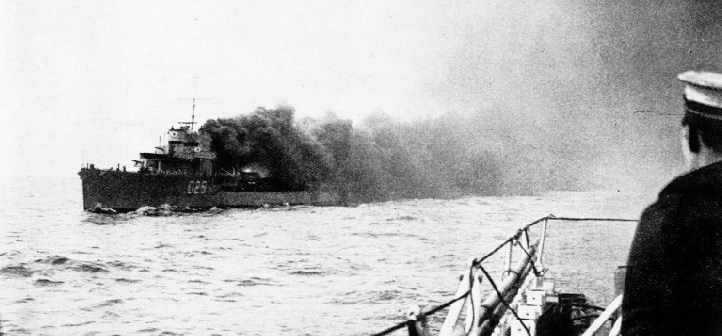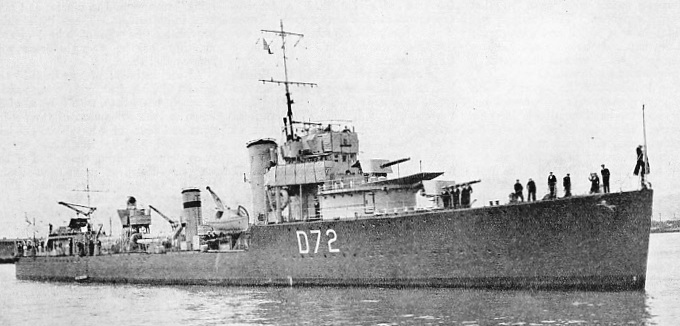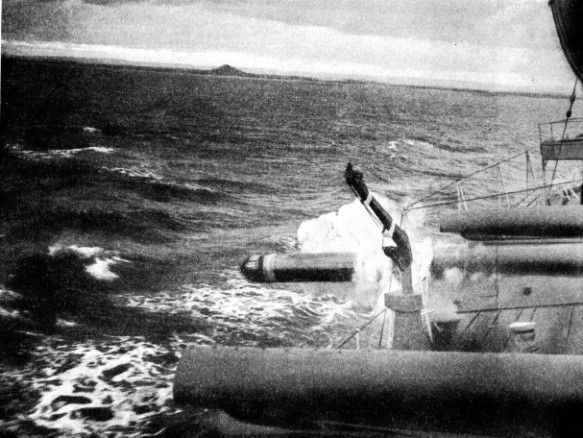The destroyers of the Royal Navy are among the fastest vessels afloat. Their main duty in wartime is to screen the battle fleet, especially from enemy submarines and destroyers, and, if necessary, to make torpedo attacks
THE NAVY GOES TO WORK - 7

LAYING A SMOKE SCREEN during exercises of the Home Fleet off Scapa Flow, Orkney. H.M.S. Warwick, the destroyer shown marked with her flotilla number D25, was completed in March 1918. At that time destroyers of the Admiralty “V” and “W” classes were the most efficient ships of their type. With a displacement of 1,100 tons, vessels of either class had an overall length of 312 feet, a beam of 29 ft. 6 in., and a maximum draught of 11 ft. 3 in. Their turbines had a designed shaft horse-power of 27,000 and drove the destroyers at a speed of 34 knots.
TOWARDS the end of the nineteenth century many eminent naval officers prophesied that the battleship would inevitably be driven from the seas by the tiny torpedo-boats that European navies were then building in large numbers. The position was similar to that which now obtains, for the big ship is declared by many critics to be the predestined and helpless prey of aircraft and submarines.
The Admiralty of the ’nineties, being composed of practical sailors, considered ways and means of countering the new menace. The torpedo-boat, despite its dreaded sting, was small and well-nigh impotent if caught in daylight on the open sea. Clearly, therefore, the antidote was a vessel equally fast, but larger, more seaworthy, and provided with sufficient gun-power to blow any “mosquito” torpedo craft out of the water.
Thus it came about that in 1893 the first destroyers were built. They were known originally as “torpedo-boat catchers”, though the more convenient term “destroyer” was soon adopted. With a displacement of 220 tons, they were nearly three times as large as the average French torpedo-boats that they had been expressly built to countervail. They had a contract speed of 27 knots and were armed with one 12-pounder, three and later five 6-pounders. While they were being built, someone at the Admiralty had the idea of giving them a torpedo armament in addition to guns. Tubes were therefore mounted, and the destroyer became, in effect, a super torpedo-boat.
As other Powers followed the British lead and built even larger boats, the two types eventually became merged into the destroyer, which in its modern form carries a heavy mixed armament of guns and torpedo tubes. Displacement tonnage has increased by seven to tenfold, and the speed has risen from 27 knots to a figure as high as 40 knots. The latest British destroyers of the “Tribal” class, of 1,850 tons displacement, are 270 tons larger than certain third-class cruisers launched for the Royal Navy in the ’nineties.
The original destroyers were “tin boxes crammed with machinery”. In weather only moderately rough they were extremely lively when travelling at speed. Green seas creamed over the low turtleback bows and sheets of spray flew over the unprotected bridge, while the little ship rolled and pitched “all ways at once”. Life on board these craft was not by any means comfortable, least of all for the “black gang” in engine-room and stokehold. The special allowance known as “hard-lying” money paid to officers and men was fully earned. These little ships provided a magnificent school of seamanship for the young officers who commanded them.
At the outbreak of war in 1914 the newest British destroyers were vessels of nearly 1,000 tons, with a speed of 33 knots and an armament of three 4-in. guns and four torpedo-tubes. Oil had superseded coal in this class several years before. During the period of the war the destroyer proved so useful that a large part of the nation’s shipbuilding resources was devoted to the production of this type of warship. More than 300 boats were built or laid down between August 1914 and November 1918, together with thirty-four flotilla leaders - which are simply enlarged destroyers.
The measure of their war service is indicated by the losses suffered by the destroyers. Seventy-eight were sunk and at least as many badly damaged by enemy action, collision, or stress of weather. They were employed on almost every conceivable mission, from screening the Grand Fleet against submarine attack to serving as “taxis” for Cabinet Ministers who wished to cross the English Channel in a hurry. Destroyers took part in every big naval action except Coronel and the Falklands; they hunted U-boats continuously in home waters and the Mediterranean; they convoyed thousands of merchantmen through the danger zone, did duty as minesweepers and in spare moments dropped mines in the Bight of Heligoland. They put in more time at sea than any other units, and their total consumption of oil is said to have greatly exceeded that of the Grand Fleet itself. Many destroyers that put in two or more years of arduous war work were still on the active list of the Navy in 1936, and this is a fine tribute to the workmanship of their builders.
The principal function of the destroyer is that of satellite to the battle fleet, to screen it from hostile destroyers and submarines, and on occasion to deliver torpedo attacks against the big ships of the enemy. For the latter purpose all but two of the destroyers built in Great Britain since 1918 carry eight 21-in. torpedo tubes on quadruple turn-tables. The 21-in. torpedo in its latest form is charged with about 450 lb. of T.N.T. (trinitrotoluene). This torpedo is capable of speeds up to 45 knots for short runs, and its maximum range (at much reduced speed) is not less than 14,000 yards. Greater speed, range and explosive power can be given to the torpedo by enlarging its dimensions, and the special torpedoes used by H.M. battleships Nelson and Rodney are 24½-in. in diameter. Although no official details are available, these monster “tin fish” must be at least 26 feet in length and weigh about three tons. They are therefore too large and too ponderous to be handled by destroyers.
The gun armament of the modern British destroyer consists of four 4·7-in. guns, firing 45-lb. shells. These guns are director-controlled - that is to say, they are aimed and fired simultaneously by electricity from a central position, in exactly the same way as the huge guns of a battleship. A “concentration shoot” by a flotilla of destroyers is an impressive sight. Nine of these little ships are strung out in a perfect line, rippling with flame and tawny cordite smoke, while away on the horizon a perfect-forest of silvery splashes denotes the presence of the target.

A DESTROYER OF THE ‘ ADMIRALTY MODIFIED W TYPE, H.M.S. Veteran was completed in November 1919. There were fourteen destroyers of this type built in the period 1919-24 and laid down under the War Emergency Programme of 1918. They have an average displacement of 1,120 tons, with a length of 300 feet between perpendiculars, a beam of 29 ft. 6 in. and a mean draught of 10 ft. 10 in. H.M.S. Veteran has a thick fore funnel and a thin after funnel.
The interior of a destroyer is an object lesson in the science of packing much into little. Boilers and engines occupy a large part of the space below deck, where 36,000 horse-power is held in leash to drive the ship, when need be, at more than 40 land miles an hour. In the sides and double-bottom are the oil tanks, containing nearly 500 tons of liquid fuel. Even in the latest destroyers the lay-out is more or less rectangular. Wardrooms and cabins are reached by vertical steel ladders, and when the officers are sitting at mess their feet probably rest on the circular hatch of an ammunition magazine.
The forecastle is a reproduction in miniature of the mess decks of a cruiser or battleship. There is less headroom, but the familiar hammock hooks and mess table gadgets are all in place, as are the aluminium lockers in which the modern bluejacket keeps his personal effects. On the upper deck most of the space is taken up by guns, torpedo tubes and other fighting equipment. Some destroyers are fitted with tramways on the quarterdeck for minelaying, and in all these vessels provision is made for carrying depth charges at the stern. The latest destroyers carry about 145 officers and men. Applied to such craft the word “boat” is a misnomer. These destroyers are able to face any weather and have great steaming endurance. Their average stowage capacity for fuel-oil is 480 tons, sufficient for a non-stop run from Portsmouth to Capetown at an economical speed.
At the beginning of 1936, 203 destroyers were in service with, or under construction for, the British and Dominion navies. Of the 169 vessels in service, 110 were beyond the age limit of twelve years and, therefore, not to be counted as fully effective. The importance of a destroyer’s age was illustrated during the combined exercises in the Atlantic in the spring of 1934, held during stormy weather. Many of the older destroyers were unable to stand up to the heavy seas and had to run for shelter, several in a battered condition. For anti-submarine work in narrow seas, however, these veterans are still regarded as valuable by the Admiralty.
Destroyers are organized in flotillas, usually consisting of a leader and eight destroyers, each flotilla being under the command of a Captain. In normal times three flotillas are attached to the Home Fleet, with a light cruiser as flagship of the Rear-Admiral (D), or Commodore (D). The Mediterranean Fleet has about the same number of flotillas, but the destroyer strength of both fleets has recently been considerably augmented.
Destroyers are attached to nearly every establishment, afloat and ashore, for a variety of purposes. One complete flotilla servos with the China Squadron. Every naval port has its contingent of “emergency” destroyers that may be sent out at short notice to assist a merchant ship in distress or to search for a missing airman.
203 Destroyers in 1936
The oldest destroyers in the Navy of 1936 were eight vessels of the “Admiralty R” type. This class was begun in 1915-16 and the destroyers displace 900 tons. Modified versions of the same type were produced by Yarrow and Thornycroft, and at least two of these craft logged 40 knots on trials.
They were followed by the “Admiralty V and W” classes, in which the displacement rose to 1,100 tons. The second and third 4-in. guns were, for the first time, mounted at a higher level to fire over the bow and stem chasers. In the later vessels of these classes 4-7-in. guns were substituted for the 4-in. guns. At the time of their construction these destroyers were probably the finest and most efficient ships of their type in existence, and the principal features of their design have since been copied by foreign navies.
At the end of the war in 1918 the Navy had so many destroyers that the building of this type was suspended for six years. In 1924-25 two experimental ships were built, H.M.S. Ambuscade and H.M.S. Amazon. Not until 1928 was the first post-war flotilla of nine units laid down. These vessels, known as the Acasta type, had a displacement of 1,350 tons, a designed speed of 35 knots, and an armament of four 4-7-in. guns, seven smaller guns and eight torpedo tubes. Seven further flotillas were built on similar lines but with minor variations in tonnage and speed. By 1936 sixty-eight units of the Acasta type had been built or laid down.
During this period, however, certain foreign navies were producing so-called destroyers that in all but name were light cruisers, of far greater tonnage and heavier armament than contemporary British vessels. To maintain a proper equilibrium, therefore, the Admiralty was compelled in 1935 to order seven destroyers, or leaders, of a size and power unexampled in the British Navy. They are known as the “Tribal” class and are named Afridi, Cossack, Ghurka, Maori, Mohawk, Nubian, and Zulu. Their displacement is 1,850 tons, an increase of 500 tons on the standard type of British destroyer. Their speed is exceptionally high. It was decided to lay down nine further destroyers of this class in 1936.

FIRING A TORPEDO from a destroyer. All but two of the British destroyers built since 1918 are armed with eight 21-in. torpedo tubes on quadruple turn-tables. The 21-in. torpedo is charged with about 450 lb. of T.N.T. (trinitrotoluene) and travels at a speed of 45 knots over short runs.
Click here to see the photogravure supplement to this article.
You can read more on “Battleships and Cruisers”, “Going to Sea” and “The Navy Goes to Work” on this website.





